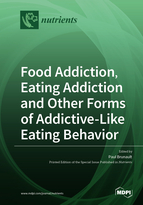Food Addiction, Eating Addiction and Other Forms of Addictive-Like Eating Behavior
A special issue of Nutrients (ISSN 2072-6643). This special issue belongs to the section "Clinical Nutrition".
Deadline for manuscript submissions: closed (30 September 2020) | Viewed by 58200
Special Issue Editor
2. INSERM UMR 1253, iBrain, University of Tours, Tours, France
3. Qualipsy, EE 1901, University of Tours, Tours, France
Interests: adult attention-deficit/hyperactivity disorder; addictive disorders; binge eating disorder; food addiction; addiction psychology; psychopathology; psychiatry; psychological assessment; clinical psychology; behavioral addictions
Special Issue Information
Dear Colleagues,
There is growing evidence that among persons with disordered eating behavior, the identification of an “addictive-like eating” phenotype for some persons could be relevant and improve our ability to design better tailored interventions. This “addictive-like eating behavior” phenotype encompasses different terms or concepts, including “food addiction”, “eating addiction”, “compulsive eating behavior”, and “food craving”, but also applies to some persons with binge eating disorder, bulimia nervosa, anorexia nervosa, or binge eating symptoms. Although these terms may theoretically refer to different underlying causes or conceptualizations of addictive-like eating, all agree on the complex and multifaceted public health problem it represents and on the similarities it shares with other addictive disorders in terms of etiology, epidemiology, and treatment.
Addictive-like eating behavior can deleteriously impact the patient’s outcome and may lead to poorer weight loss evolution, increased prevalence of co-occurring medical and/or psychiatric disorders, and/or lower quality of life. One of the key challenges for the present and future research is to better identify this subpopulation of patients exhibiting this addictive-like eating phenotype, and to identify the psychological/psychiatric factors and biological mechanisms underlying this increased vulnerability to addictive-like eating. Such preliminary knowledge is crucial for enabling the development of interventions targeting these vulnerability risk factors and, ultimately, improving patient outcomes.
The goal of this Special Issue of Nutrients is to give an update on the biological, psychological, psychiatric, and social factors underlying the increased vulnerability to addictive-like eating behavior (including, but not limited to, food addiction, eating addiction, and binge eating), and to contribute to a better identification of this phenotype among persons with disordered eating. This Special Issue also aims to contribute to the debate on which interventions should be proposed to whom, and how they should be integrated into the multidisciplinary care proposed for patients with addictive-like eating behavior.
We are very excited about this upcoming Special Issue, and are looking forward to reading your interesting proposals. We welcome all types of contributions that improve the scientific knowledge in this important field and fill the current gaps in the existing literature.
Potential topics include, but are by no means limited to, the following:
- All forms of addictive-like eating behavior, including food addiction/eating addiction/compulsive eating behavior, and food cravings, as well as binge eating symptoms or binge eating disorder and other eating disorders;
- Addictive-like eating among persons with eating disorders (i.e., anorexia nervosa, bulimia nervosa, binge eating disorder) or disordered eating symptoms (i.e., binge eating, cognitive restraint, emotional eating);
- Addictive-like eating among persons with obesity, including bariatric surgery;
- Addiction transfer/addiction switch before or after addictive-like eating management;
- Addictive-like eating behavior and weight;
- Co-occurring psychiatric and medical disorders associated with addictive-like eating behavior;
- Psychopathological factors or psychiatric disorders that may underlie the increased vulnerability to addictive-like eating behavior;
- Relationship between addictive-like eating and other addictive disorders, including substance-related disorders and behavioral addictions;
- Clinical, epidemiological, genetic, neuroimaging, or preclinical studies;
- Treatment strategies;
- Discussion about the terms used to describe the addictive-like eating phenotype (e.g., food addiction versus eating addiction).
Dr. Paul Brunault
Guest Editor
Manuscript Submission Information
Manuscripts should be submitted online at www.mdpi.com by registering and logging in to this website. Once you are registered, click here to go to the submission form. Manuscripts can be submitted until the deadline. All submissions that pass pre-check are peer-reviewed. Accepted papers will be published continuously in the journal (as soon as accepted) and will be listed together on the special issue website. Research articles, review articles as well as short communications are invited. For planned papers, a title and short abstract (about 100 words) can be sent to the Editorial Office for announcement on this website.
Submitted manuscripts should not have been published previously, nor be under consideration for publication elsewhere (except conference proceedings papers). All manuscripts are thoroughly refereed through a single-blind peer-review process. A guide for authors and other relevant information for submission of manuscripts is available on the Instructions for Authors page. Nutrients is an international peer-reviewed open access semimonthly journal published by MDPI.
Please visit the Instructions for Authors page before submitting a manuscript. The Article Processing Charge (APC) for publication in this open access journal is 2900 CHF (Swiss Francs). Submitted papers should be well formatted and use good English. Authors may use MDPI's English editing service prior to publication or during author revisions.
Keywords
- Food addiction
- Eating addiction
- Addictive-like eating behaviour
- Compulsive eating behaviour
- Impulsive compulsive spectrum disorders
- Co-occurring psychiatric disorders
- Obesity
- Addictive disorders
- Eating disorders
- Binge eating disorder
- Psychiatry
- Psychology
- Psychopathology
- Neurobiology







